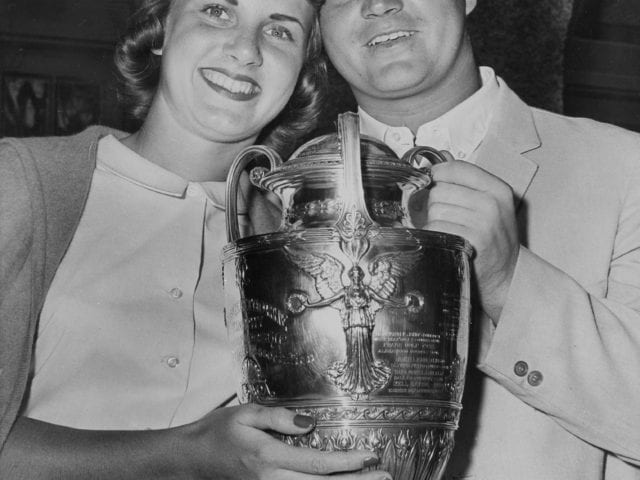Jack Nicklaus’ amateur career, although relatively short as compared to some of his Top 50 Amateurs of All Time counterparts, packed a powerful punch. It began in 1957 where Nicklaus won the International Jaycee Junior Golf Tournament, having lost the previous year in a playoff. Nicklaus also competed in his first of 44 consecutive U.S. Opens that year, but missed the cut. In 1958 at age 18, he competed in his first PGA Tour event, the Rubber City Open, at Akron, Ohio, tying for 12th place after being just one out of the lead at the 36-hole mark, and made the cut in the U.S. Open, tying for 41st place. Nicklaus also won two Trans-Mississippi Amateurs – in 1958 at Prairie Dunes Country Club and 1959 at Woodhill Country Club, with final match victories of 9 & 8 and 3 & 2, respectively. Also in 1959, Nicklaus won the North and South Amateur at Pinehurst, North Carolina and competed in three additional PGA Tour events, with his best finish being another 12th place showing at the Buick Open.
While attending Ohio State, he won the U.S. Amateur twice (’59, ’61), and an NCAA Championship (1961). In the 1959 U.S. Amateur at The Broadmoor in Colorado Springs, CO, Nicklaus beat two-time winner and defending champion Charles Coe 1-up in the final 36-hole match when he birdied the eighteenth hole. This was significant not only because of Coe’s proven ability as a player, but also because Nicklaus became the then-youngest champion in the modern era, second only to Robert A. Gardner, who won in 1909.
In 1961, Nicklaus became the first player to win the individual title at the NCAA Championship and the U.S. Amateur in the same year. He was followed by Phil Mickelson (1990), Tiger Woods (1996), Ryan Moore (2004), and Bryson DeChambeau (2015). Nicklaus also won the NCAA Big Ten Conference Championship that year with a 72-hole aggregate of 283, while earlier claiming the Western Amateur in New Orleans. In his second U.S. Am victory in 1961, Nicklaus convincingly defeated Dudley Wysong 8 & 6 at Pebble Beach in the 36-hole championship match. For the week, Nicklaus was 20 strokes under par, including 34 birdies and two eagles.
At the 1960 U.S. Open, twenty-year-old Nicklaus shot a two-under par 282, finishing in second place two strokes behind Arnold Palmer, who won the tournament for the only time with a final round charge of six-under-par 65. This score remains the lowest ever by an amateur in the U.S. Open. Nicklaus played the final 36 holes with Ben Hogan, who later remarked that he had just played 36 holes with a kid who should have won by 10 shots. During the final 36 holes, Nicklaus was two-under-par; he had shot every round of the tournament at or below par and was the only entrant to do so. Nicklaus had led by two shots with six holes to play. In 1960, Nicklaus also tied for 13th in the Masters Tournament. He tied for fourth in the 1961 U.S. Open, three shots behind champion Gene Littler, having played the final 54 holes one under par. Each of these three major championship finishes designated Nicklaus as low amateur. However, Nicklaus’ one-under-par 287 tied for seventh in the 1961 Masters Tournament, and was second that year only to Charlie Coe’s low amateur placing, when he tied for second with Arnold Palmer at seven-under par 281, one shot behind champion Gary Player.
Nicklaus represented the United States against Great Britain and Ireland on winning Walker Cup teams in both 1959 and 1961, decisively winning both of his matches in each contest. On the 1959 trip to Britain, he also made his only attempt at the British Amateur, the world’s oldest international amateur event, at Royal St George’s Golf Club, reaching the quarterfinal round (top 8). He was also a member of the victorious 1960 U.S. Eisenhower Trophy team, winning the unofficial individual title by 13 shots over teammate Deane Beman with a four-round score of 269, a record which still stands; this score was 18 shots lower than Ben Hogan’s earlier U.S. Open aggregate of 287 at the same site (which had, however, been scored under much tougher conditions). For three straight years (1959–1961), Nicklaus was named the world’s top amateur golfer by Golf Digest magazine.
We all know what “The Golden Bear” made his biggest mark in the professional game with a record 18 major championships, but it was his amateur career that catapulted him to the confidence to reach those heights.

